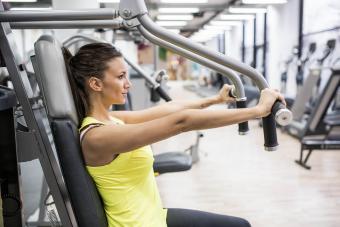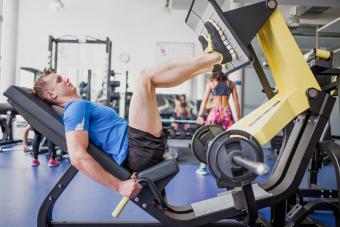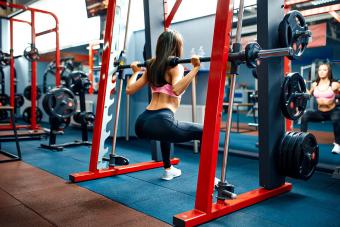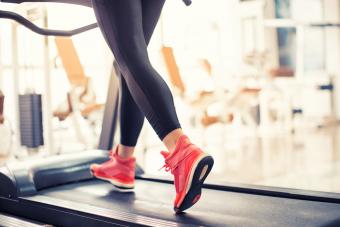
Exercise machines at the gym can be intimidating if you don't know how to use them. It might also be hard to plan and execute an effective workout if you're not familiar with common gym machines and the muscles they work.
Luckily, most health clubs have similar equipment. So once you're familiar with the basic machines at your location, you can confidently stride into any gym and get started with your workout.
The 5 Most Popular Cardio Machines
Most gyms offer machines that help you to improve your aerobic fitness, burn calories, and boost heart health. Although the brands and styles may vary, these five mainstays are the most common cardio exercise machines at the gym.
Treadmill

A treadmill offers you the opportunity to walk, jog, run, or combine any of those formats into an interval workout. Treadmills are easier on joints than running outdoors, and they give you the ability to control the intensity of your workout so that you can reach a target heart rate to meet workout goals.
To use a treadmill, step onto the deck first before starting the machine. The treadmill deck is the area that surrounds the belt and does not move. Press the start button and set a slow walking pace. Then step onto the belt and start walking. Once you feel comfortable and steady, increase the pace or the incline to reach the workout intensity you desire.
Pro Tip: Try not to use the handrails when walking or running on the treadmill. Even if you are walking on a steep incline, you'll use more core and leg muscles if you stabilize your body without using your hands for stability.
Elliptical Machine

Offering a smoother ride than the treadmill, elliptical machines allow users the ability to simulate walking or running movements with no impact. During each step, the elliptical footpad stays underneath your foot, so there is no impact during turnover. Some elliptical machines also offer arm handles that move, while others have stationary rails.
To use an elliptical machine, you'll step up onto the footpads before turning on the machine. Use the handrails for balance as you select a pre-programmed workout or your preferred time and level. Once the machine starts moving, you'll notice that the footpads guide your foot through each step. If it feels too easy, increase the level to make each step harder.
Pro Tip: If your elliptical has moving arm rails, you can use them to get a (slight) upper body cardio workout. But while the arm movements can help to elevate your heart rate, they are not likely to challenge your upper body enough to build strength.
Stationary Bike

Stationary bikes at the gym provide a cycling experience indoors. Most gyms have traditional upright bikes and recumbent bikes. Many gyms have indoor cycling group fitness classes where participants use spin bikes. Each type of stationary bike can help you to improve cardiovascular fitness and strengthen the muscles in your lower body (quadriceps, hamstrings, glutes, and calves).
To use a traditional or recumbent stationary bike, follow instructions on the machine to set the seat height properly and guide your first workout. Challenge yourself by adding enough resistance, so it feels like you are pedaling through soft terrain and not spinning through thin air.
Pro Tip: If you choose to take a spin class, go to your first session a few minutes early and introduce yourself to the instructor. Ask them to set up the bike for your body. Getting a proper fit on the bike is imperative for enjoying a safe, fun, and effective workout.
Stair Climber

These "stairs to nowhere" deliver a tough cardio workout that helps strengthen the lower body. Some stair steppers look similar to an elliptical with footpads that stay under your feet during each step. But other gym machines look more like an escalator that requires you to lift your foot with each step.
To begin using a stair stepper or climbing machine, start with small steps that don't require a big "lift" with each repetition. Most machines have a quick start button that you can use to begin at the lowest level. As you add resistance by increasing your level, you'll notice that each step becomes steeper and harder.
Pro Tip: This is another common gym exercise machine where balance can enhance your workout. Once you feel stable on the machine, try to step without using the handrails so that your core muscles are engaged.
Rower

Rowers mimic the movements of rowing a boat, providing a great cardio workout while strengthening the legs, chest, and back. Many bootcamp-style workouts use rowing machines because they offer an efficient total body workout.
To use a rowing machine, you'll start by sitting on the molded seat and placing your feet on the footpads. Tighten the straps, so your feet are secure, then grab the rowing handle with an overhand grip. Using a rowing motion, pull the handle towards your torso while straightening your legs. Reverse the move and repeat.
Pro Tip: Try not to hunch your back when using a rower. Keep the chest open and the back strong and upright. Keep your grip secure, but avoid tightening your hands so much that your hands hurt.
5 Popular Strength Machines
Most gyms provide different types of equipment to help you build muscle and improve strength. For instance, you're likely to see dumbbells, barbells with weight plates, and kettlebells in the free weight training area.
But usually, there is also an area where you'll find strength training exercise machines. According to the International Sports Science Association (ISSA), machines are often safer for a beginner because they can offer more stability, although some machines offer more stability than others.
These five popular strength training machines at the gym can help you to get an effective full-body strength workout. Be sure to read the instructions on each machine to learn how to stay safe and optimize each movement.
Chest Press

The seated chest press machine helps you to strengthen your pectoralis muscles on the front of your chest, the triceps on the back of the arm, and deltoid or shoulder muscles.
To use the machine, you sit on a padded seat and press handles away from the torso to an extended position (with elbows almost straight) and then control the release back toward the body by bending at the elbow.
Pro Tip: Be sure to keep the back strong as you press the handles forward and keep the breath steady throughout the duration of the move.
Lat Pulldown

The lat pull is designed to strengthen the latissimus dorsi muscle, a large wing-shaped muscle on your mid-back. This machine features a seat and an interchangeable bar or handles that hang from above your head.
To use the lat pulldown, you'll need to grip the overhead bar or handles so that the hands are slightly wider than shoulder-distance apart. From a seated position, pull the bar down towards your upper chest, then release it to the starting position and repeat.
Pro Tip: If your hips lift off the seat when you return the bar to the starting position, you're lifting too much weight. Keep your hips firmly planted during each repetition.
Leg Press

The leg press machine helps you to strengthen the muscles in your lower body (glutes, hamstrings, and quads) by positioning your body so that your legs have to move weight away from your hips.
To use the leg press, you'll sit in the padded seat and place your feet on a wide platform. Once you're in position (with ankles and knees aligned with your hips), you'll then move the platform towards your body so that your knees are bent and close to your chest. Different machines have different levers that assist this movement. Finally, using your leg muscles, press the platform away from your body until the knees are extended, and then reverse and repeat.
Pro Tip: You can challenge yourself by using the leg press machine and working just one leg at a time. This forces you to use the muscles in each leg equally so that you don't rely on your "strong side" to do most of the work.
Smith Machine

The Smith machine can assist a weighted squat exercise by anchoring the barbell and guiding its movements. Some people also use a Smith machine for a chest press when lying on a weight bench.
To do a squat exercise with a Smith machine, start with the bar racked (so no weight is on your body) and position it so that it is resting on the meaty part of your upper shoulders. Place your hands on the bar at shoulder height with an overhand grip. Rotate the bar back slightly to remove it from the rack and lower the hips into a deep squat position. Reverse the move and repeat. Complete the desired number of repetitions and re-rack the weight before moving away from the machine.
Pro Tip: Racking and unracking the bar can be tricky. Try the squat first with no weight plates on the bar. Once you feel comfortable with the move, add weight plates to challenge your muscles.
Cables

A versatile machine, this large unit features cables and pulleys for strength work. The great thing about this gym machine is that there are a number of different attachments and most setups offer clear instructions about different ways to use them.
For instance, cables can be used to do biceps curls for the front of the upper arm, triceps extensions for the back of the upper arm, or even assisted pull-ups for the upper back and arms.
Pro Tip: Cables offer less stability than other strength training gym machines. So go light on the resistance when trying a new move. As you get comfortable with good form, add resistance slowly.
Tips for Using Exercise Machines at the Gym
Whether you are using cardio equipment, free weights, or strength training machines, there are a few basic guidelines you should follow at the gym to make your experience safe and enjoyable.
-
Be mindful of time limits, especially on cardio machines. Some gyms suggest a 30-minute limit during busy periods.
-
Sit on equipment only when you are using it to exercise. Other exercisers may be waiting to use a machine, so don't use it as a resting spot.
-
Wipe down equipment after use. Gyms usually provide wipes or spray bottles or both to help you sanitize machines for the next user.
-
Leave your cell phone in the locker room.
If you don't know how to use a piece of equipment, don't be afraid to ask. Most health clubs have staff on the fitness floor to provide help. These trainers can guide you through proper machine selection and setup. They can also assist in making sure you have good form while using the equipment so that your workout is not only safe but also effective and enjoyable.







